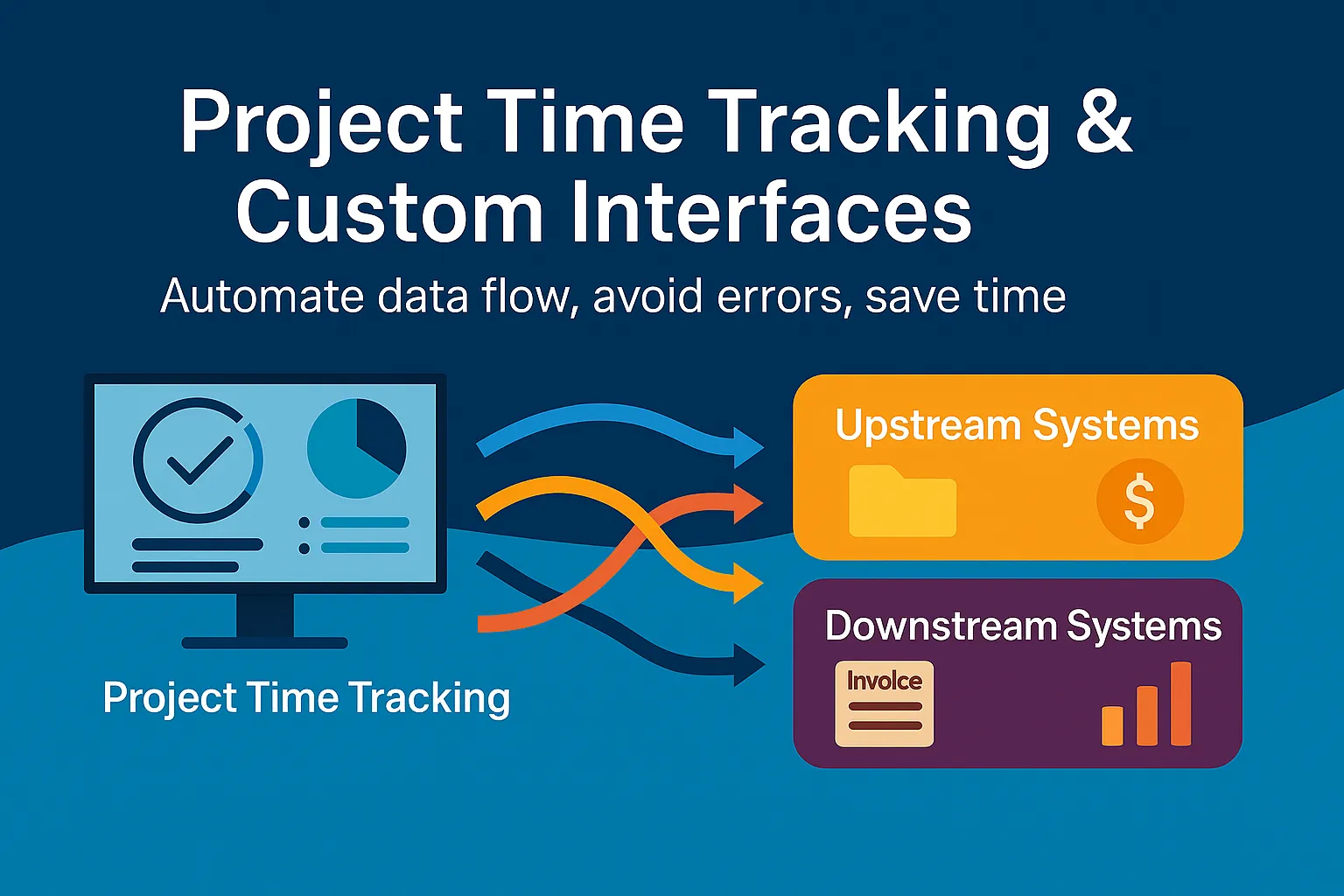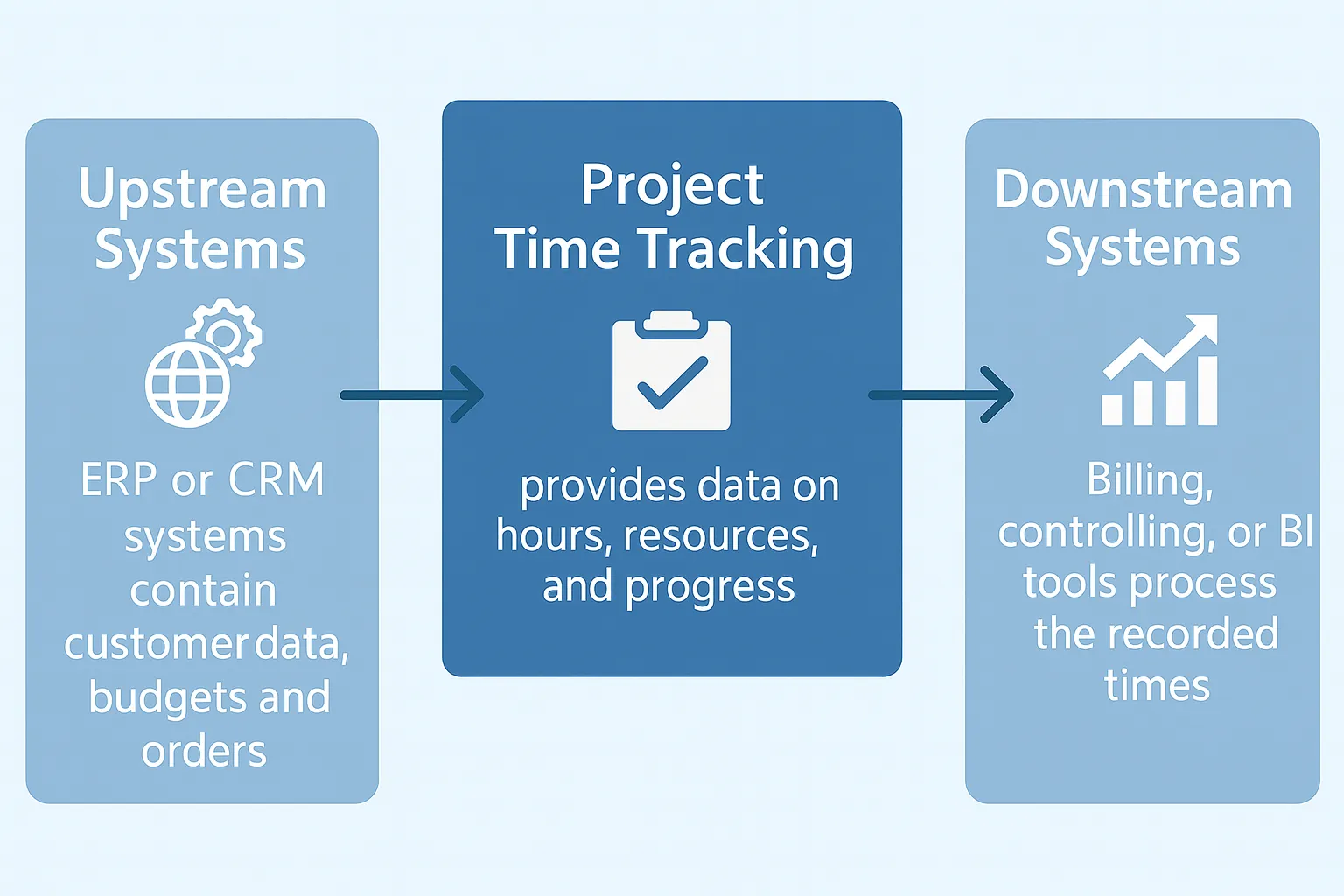Optimize Project Time Tracking – Leverage Integrations
by Michael Kubitschka

In many organizations, a project time tracking system doesn’t live on a greenfield. It’s embedded in a complex landscape with upstream systems (e.g., ERP) and downstream systems (e.g., billing, reporting). To unlock the full value of a solution like time cockpit, you need tailored integrations and automated jobs that seamlessly import and export data or trigger workflows.
That’s exactly where our years of experience come in: we build custom-fit integrations and automations aligned to your processes and we also support you in setting up and configuring your Microsoft Azure subscription.
Why integrations are crucial in project time tracking
Today, there are hardly any isolated IT systems. Especially in project work, success depends on seamless collaboration across systems:
- Project time tracking provides data on hours, resources, and progress.
- Upstream systems like ERP or CRM contain customer data, budgets, and orders.
- Downstream systems like billing, controlling, or BI tools further process the recorded time.

If an integration is missing or unreliable, issues appear immediately:
- Duplicate work — the same data must be entered multiple times.
- Error sources — manual transfers lead to incorrect invoices and unreliable KPIs.
- Time loss — data isn’t available in real time; billing is delayed.
- Lack of transparency — management lacks an up-to-date overview.
- Growth bottlenecks — processes don’t scale with company size.
The value of working integrations
Well-designed project time tracking integrations deliver:
- Real-time transparency: Always up-to-date data in every system.
- Automation: Reminders, budget checks, and invoicing run automatically.
- Error reduction: No typos or misassignments (e.g., booking to the wrong project).
- Faster invoicing: Hours flow straight into the billing system.
- Informed decisions: Accurate KPIs for project managers, controllers, and management.
With the right integration, project time tracking becomes the hub for controlling, corporate steering, and customer satisfaction.
🚀 Tip: We support your digital transformation, critically analyze existing processes, and help from optimization through to technical implementation.
Typical use cases from our practice
Across many client projects we see: automation and integrations are often the decisive lever for efficiency. The spectrum ranges from simple reminders to complex system coupling:
Automations
Recurring tasks can run entirely without manual effort, for example:
- Sending reminder emails for time entry
- Automatically creating Outlook appointments for absences
- Periodic checks for working-time rule violations with notifications
Project time tracking functions
Automations also create tangible benefits in daily project work, such as:
- Notifications when budgets are exceeded
- Automated project status reports
- Synchronization of project data with ERP systems
System integrations
Time Cockpit can be integrated seamlessly with a wide variety of systems, including:
- Microsoft Dynamics NAV / Business Central
- Microsoft CRM
- SharePoint
- SAP
- Azure DevOps
- Jira
- Various on-premises systems
Our experience: the list of potential integrations is long and often the key to maximum efficiency.
Our technology foundation: Microsoft Azure
For integrations and jobs we rely on Microsoft Azure, a modern, secure, and highly scalable cloud platform.
In most projects we use Azure Functions:
Azure Functions is a serverless cloud service for building event-driven applications without managing servers. This enables lean, efficient integrations that only incur costs when they run often even free within the included quota.
📄 Learn more about Azure Functions in the Microsoft docs
Securely connecting on-premises systems
Many clients want to integrate on-premises systems with their project time tracking. Here we use Azure Hybrid Connections:
Azure Hybrid Connections provides secure access from Azure to local resources without complex VPNs. A small component in the corporate network establishes an encrypted connection to the cloud.
📄 More on Azure Hybrid Connections
💡 Even if you still run software in your own data center or network, there’s nothing stopping you from using Time Cockpit as a SaaS solution. We’ll help you connect your on-premises world seamlessly with the cloud.
Time Cockpit Web API for any integration
The time cockpit Web API is the heart of flexible connections between time cockpit and other systems. It enables virtually any kind of data exchange or process integration, from simple queries to complex, bidirectional interfaces.
- Import and export of data
- Triggering actions
- Fetching lists and results
- Retrieving reports
- and more
In practice, this means: an ERP can automatically create new projects and customers in time cockpit; a CRM writes recorded project hours into the customer history; or a BI tool fetches up-to-date analytics for management reports.
Our Azure Functions use this API to synchronize data between time cockpit and external systems. The result is integrations that automate processes, eliminate errors, and ensure all connected systems always work with the latest information.
Why tailor-made integrations?
💡 Systems like SAP or Azure DevOps are highly customizable. Companies can add custom fields, workflows, and data structures. To make those customizations work smoothly with time cockpit, you need flexible, customer-specific integrations.
Our development approach
- Requirements analysis — clarify data flows and processes
- Technical design — architecture and technology selection
- Development & testing — build with Azure Functions, connect APIs, perform security tests
- Go-live & monitoring — rollout, observability, optimization
Conclusion
Custom project time tracking integrations are the key to automated processes, error-free data flows, and up-to-date information across all systems.
With Azure Functions, Hybrid Connections, and the time cockpit Web API, we build integrations that fit your processes exactly—cloud, on-premises, or hybrid.
The result: greater efficiency, better data quality, faster billing and a clear competitive edge.